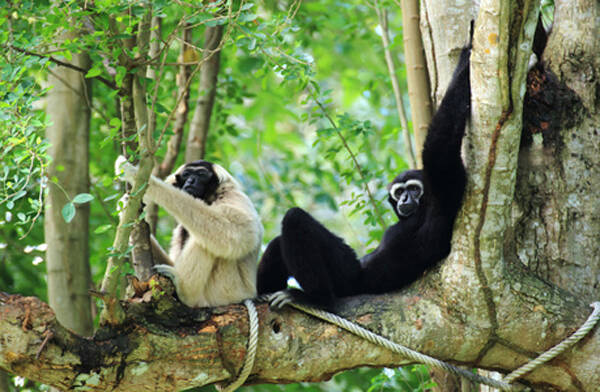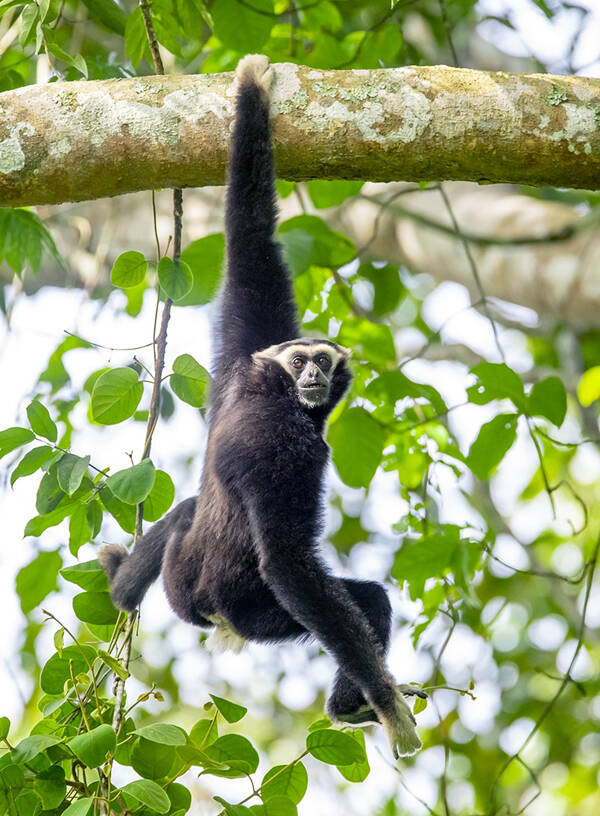Hylobates pileatus
IUCN
LCBasic Information
Scientific classification
- name:Hylobates pileatus
- Scientific Name:Hylobates pileatus,Pileated Gibbon,Fence-crowned gibbon, Crested gibbon
- Outline:Primates
- Family:G.family genus
Vital signs
- length:45-64cm
- Weight:5.4-5.5kg
- lifetime:About 20 years
Feature
A tuft of black hair on the top of the head that looks like a crown
Distribution and Habitat
Pileated gibbons are distributed along the Mekong River basin, from southern Thailand to western Cambodia, but can now only be found in southeastern Thailand, southwestern Laos and northwestern Cambodia.
Mainly inhabit tropical forests. Live below 1,500 meters above sea level. This species lives in primary and secondary forests, most often tropical evergreen broad-leaved forests and tropical deciduous monsoon forests. Live in mountain forests with dense evergreen plants, tall and humid. Like to move in tall tree canopies.
Appearance
Pileated gibbons weigh 4-8 kg and are 450-640 mm long. The average weight for females is 5.4 kg, and for males is 5.5 kg. They have a long trunk, a slender body, long arms, short legs, broad shoulders and narrow hips; their palms are longer than their feet, and their finger joints are long; they have calluses on their hips and no tail; they have long canines; they have no cheek pouches; they have a vocal sac in their throats and are good at singing. The coloring of their hair varies from gray to brown. The hair on the top of the head and chest is darker than the rest of the body. They have hip pads and long canines.
There is no difference in the fur between the sexes, and the pink skin at birth is covered with light yellow fur, which is shiny. Black spots appear on the head and chest at 10-12 months of age. These black spots continue to grow until sexual maturity. Adult females have a large black patch on the ventral surface of the groin that forms an inverted triangle from the top
Details
Pileated Gibbon (scientific name: Hylobates pileatus) is also known as Pileated Gibbon in English. It has no subspecies.

Pileated gibbons usually form a family of 4, including an adult male and an adult female, and the rest are semi-adult and young gibbons, with an adult male serving as the leader. Gibbons have a relatively long maturity period, and family relationships are not only stable, but also harmonious and friendly. Family members are generally very harmonious, caring for each other and defending each other. It is also common to see groups of 3 or 4 unrelated solitary apes. These are adult Pileated gibbons who have been forced to leave their families and have not yet established their own territories.
The habits of Pileated gibbons are similar to those of other gibbons. They live a family life with male and female partners and are territorial. The territory of each group is about 34.2 hectares. It is a diurnal animal, active for 8 to 10 hours a day. During the day, it climbs and grabs branches with its arms on the trees 20-30 meters high in the forest, swings and jumps, and uses both its front and rear limbs to move very fast. Due to the high characteristics of this movement, the direction of the chest and arms is often changed. Long-term evolutionary adaptation has made the shoulders flat on both sides, which are not as wide as those of monkeys. The elbows are longer and can rotate 360 degrees in all directions. It can move forward and backward quickly. The feet only play the role of assisting pedaling. It can walk upright on the ground, holding its hands on its head to keep balance when walking. This fashion of walking cannot be maintained for long distances. They do not like swimming and avoid entering water. They have a keen sense of hearing and smell, are timid and afraid of cold.
The calls of Pileated Gibbons are the main form of communication among group members. Every morning, males and females sing in chorus, usually for 15 minutes, with ups and downs or sad and low sounds. The male's call is sandwiched between the female's call, and at the end of the call, a tail sound is added. Tactile communication is also important between parents and their offspring. Tactile communication involves grooming, mating, playing, and sometimes aggressive behavior. In addition to vocal and tactile communication, these animals also use facial expressions, gestures and body postures to communicate with their own kind.
Pileated Gibbons consume a lot of fruit. Like other gibbons, these animals are mainly frugivores. They also eat a variety of other foods, including leaves, flowers and insects. Due to their high activity, it is necessary to eat calorie-rich foods, and fruits have a high calorie content.

Pileated gibbons do not have a strict breeding season. Female estrus lasts 27-30 days. Menstruation lasts 4-5 days. The testicles of male pleated gibbons droop in late adolescence, and the penis is the shortest in the genus, making it the most common species among gibbons. Females reach sexual maturity at about 7.5 years old, and males reach sexual maturity at 5 to 8 years old. The average gestation period of females lasts 6 to 7.5 months. After mating and conception, they still move with the group. After 3-4 months, their abdomens bulge slightly. As the fetus grows, their abdomens gradually increase, and their daily actions become more cautious, but they still stay with the group until giving birth. Birth usually occurs in autumn and early winter, and only one cub is born per litter. The cubs are weaned at 1 to 2 years old, and the females will take care of them for up to two years. After that, the cubs will continue to live in the family group and help their parents take care of their younger siblings. When they are close to sexual maturity, they will slowly leave the group and live independently. This species reproduces once every 2 to 3 years.
In Cambodia, the main area where the Pileated Gibbon lives is the Cardamom Mountains, which are relatively intact in the southern and western parts, with a density of 1-2 groups/square kilometer, about 20,000. In the north, where the habitat is similar but more open, a very small proportion of the population lives in evergreen broadleaved forests. The estimated 1,000 groups in the southwestern Bokor National Park in Cambodia are also likely to have been isolated from the original range. The total number in Cambodia is over 35,000 (2005 census). The number in Laos is significantly smaller, mainly because the distribution range is very small (1999). In Thailand, in the 2004-2005 census, it was estimated that there were about 12,000 (3,000 breeding) distributed in the four largest forest areas, including five major protected areas (Khao Yai National Park, Thap Lan National Park, Khao Ang Junai Reserve and Phnom Penh Island Reserve). Together with 15 other small and highly fragmented protected areas, the number is between 1,000 and 2,000. The distribution density is generally low, averaging close to one group (average 4)/km2, with higher density in some remote mountainous areas. As early as the 1994 survey, the total number in Thailand was estimated to be 30,000.
Protect wild animals and eliminate game.
Maintaining ecological balance is everyone's responsibility!








